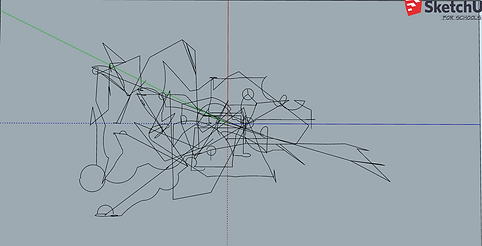top of page

MOTION TRACKING
This construct works from an architectural perspective encompassing the physical, visceral and negative space in a geometric format similarly to Libeskind and William Forsythe. Although Libeskind is defined as an architect and Forsythe a choreographer, both work with documenting the process rather than the outcome and "have an understanding of the body in space as a geometric construct" (Spier, 2005, p.358). This aspect can sometimes be lost, particularly with somatic forms of practice as we immerse ourselves in the subjective realm with our bodies becoming more than just a spatial occupation but a living breathing presence (Emslie, 2009). This intersubjectivity can be identified and understood but requires extensive experience in reading the body (Stancliffe, 2018, p.220) making the performance only partially accessible. Steve Paxton addresses this issue as most of his work is heavily based around somatic practice and sought for a way to document the intersubjectivity through motion tracking (Stancliffe, 2018). This form of recording was originally created in order to help computer programmers to understand the internal mechanics of movement to generate more realistic moving characters for games (Abramova, Corradini & Nordentoft, 2018), however artists such as Paxton began to use it as a living documenting process itself as it not only documents the movement but presents a virtual experience of the how.
This process lent itself to my touch methodology and by using the interactive software Sketchup I was able to reconstruct my improvised movement in a graphic manner defining each body part's spatial consumption whilst layering them to enhance their relations and movement patterns. Unlike photographs or video footage of the body itself which condense the event into a two-dimensional viewing platform, the rotational element enables the observer to access all perspectives, even those we would not normally indulge in conventional performances such as a birds eye view or the dancer's perspective. By collating these the observer construes a multidimensional comprehension of the methodology and movement as "the image occupies a paradoxical space, as the body is visibly removed, yet perceptually present" (Blades, 2015, p.156). Following on from this, the visualisation of the motion is preserved offering a comparable analysis between each technological sketch to witness whether over time, the mover occupies habitual movement patterns and a preference to certain spatial decisions. This reinforces how motion tracking does more than just document movement but acts as a choreographic tool for improviser's to develop their practice by insinuating new modes of creation and offering the possibility to alter habits (Allen, 2010).
As you watch the videos below please ensure you turn your volume up as they contain a voice over explaining the method and my analysis of each one.
Workshop 1

Workshop 2

Workshop 1





Workshop 2





bottom of page

